The following essay will appear in Climates: Architecture and the Planetary Imaginary, published this spring by the Avery Review and Lars Müller Publishers.
Climate change is everything, a story and a calamity bigger than any other. It’s the whole planet for the whole foreseeable future, the entire atmosphere, all the oceans, the poles; it’s weather and crop failure and famine and tropical diseases heading north and desertification and the uncertain fate of a great majority of species on Earth.
—Rebecca Solnit1
Apprehending what is significant … may require “escaping the fascination of the picture” by adopting another perspective—a partial or partisan perspective, the perspective of a part. From this …, the whole will not appear as a whole. It will appear with a hole. The perspective from which the hole appears is that of the subject…
—Jodi Dean2
Perhaps more than any other phenomenon imaginable, climate change is dizzyingly convoluted, entailing many often correlated and at times seemingly contradictory things happening in multiple places at once, at varying rates and scales, and with myriad types and degrees of consequence. In addition to certain unprecedented material-environmental conditions, it thus poses profound representational dilemmas. This is compounded further by our immersion in this ever accelerating “everything-ness,” the edges of which are challenging, if not impossible, to sense.3 From what vantage point, then, might we engage climate change—this multiscalar, multitemporal, multidimensional, and multidisciplinary “shadow that is no less ominous because it is formless and obscure,” to borrow Rachel Carson’s analogy for pesticide contamination from 1962?4

The term dysphoria (from the Greek: “difficult to bear”) denotes a state of extreme unease that can also, in a psychiatric context, mean someone who becomes uncomfortable in her own body or skin. Common symptoms include emotional distress or its seeming opposite, numbed indifference. Indeed, it might be argued that our planetary home, or oikos, in its human-caused, heat-trapping state of precariousness, has become a newly foreign medium in which we do not as yet know how to move. In a recent essay titled “Planetary Dysphoria,” the literary theorist Emily Apter traces the lineage of a now pervasive and distinctly apocalyptic “aesthetics of planetarity,” which she summarizes as “the geo-psychoanalytic state of the world at its most depressed and unruhig, awaiting the triumphant revenge of acid, oil, and dust.”5 One might think here, too, of the growing number of publicized cases of depression among leading climate scientists, or what some refer to as the “climate anxiety” or “pre-traumatic stress disorder” experienced by those who most clearly grasp the magnitude of our current atmospheric-environmental crisis, as well as the limited capacity of their own research, thus far, to spur anywhere near a sufficient response.6
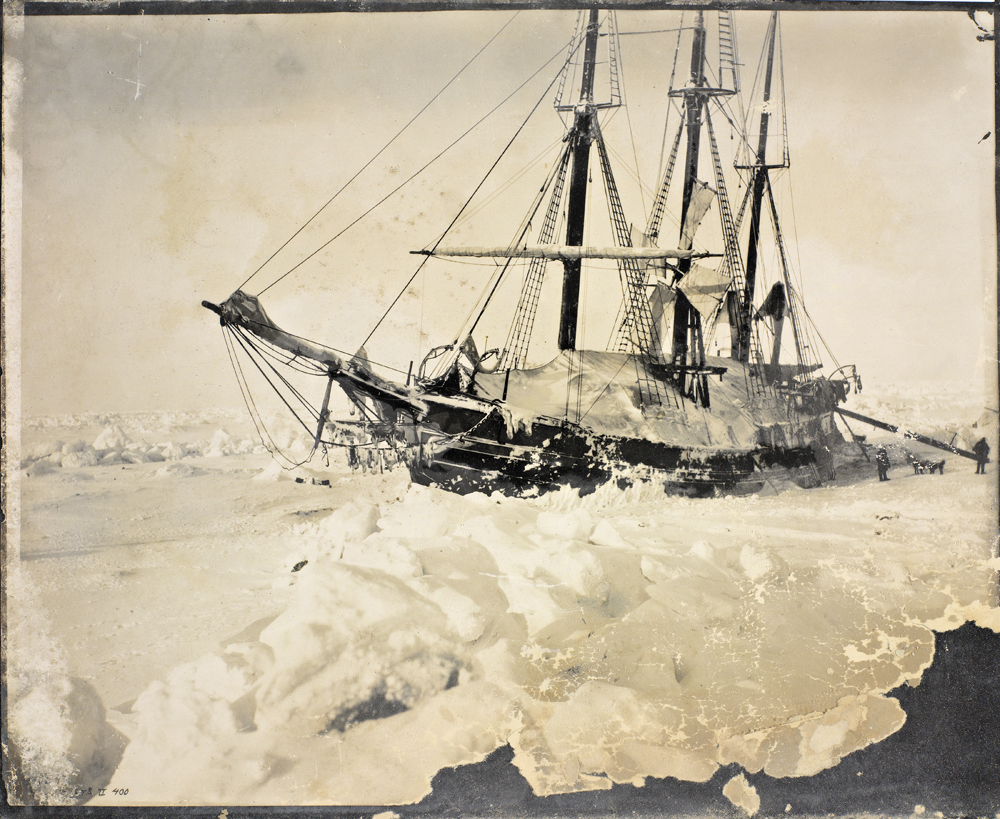
Under the immense and bewildering weight of climate change, how might we hack out viable positions—or holes within the whole, as the political theorist Jodi Dean puts it—from which to proceed? What kinds of representation (visual and otherwise) are adequate to the task of conveying climate change, and perhaps most importantly, to stemming dysphoric paralysis while triggering critical thinking and action? Using A People’s Archive of Sinking and Melting (2011–present) by the California-based artist Amy Balkin as one example, this essay will consider those representations that dwell in “the sticky materiality of practical encounters,” moving across scales and registers in order to forge not seamless perspectives but ones that are adequately fractured and muddy.7
The existing visual culture of climate change—brimming with depictions of ravaged landscapes, polar bears atop waning ice, and techno-sublime satellite views—adheres largely to an illustrative mode, despite the incongruousness and even muteness of such a manner in the face of newly complex entanglements between the human and nonhuman, not to mention the kind of attritional “slow violence” associated with climate change.8 The genre of science fiction may hold a particular potential to wrangle with our present planetary crisis in its oblique relation to the (nonfictional) world, or its invocation of vantage points tied to imagined other times and places. That being said, science fiction’s indulgence in the spectacle of disaster has a tendency to turn us into spectators, desensitized and deactivated, by inviting “a dispassionate, aesthetic view of destruction and violence—a technological view,” as noted incisively by the cultural critic Susan Sontag in 1965.9 In any case, the prominent resurgence of dystopian, end-of-the-world imagery in both mass culture and the highly compelling work of some contemporary artists and experimental scholars certainly warrants further attention.10
I want to touch briefly on two dominant visual tropes with a documentary orientation, both of which involve the compression of climate change into a single picture, or its encapsulation “in a data point or disastrous image.”11 First, let us consider that of the iconic, lone polar bear struggling for survival in a rapidly disappearing habitat. As with countless other portraits of the Earth and its beings in peril, here it is a single, tragic victim that occupies center stage. Our own viewpoint is proximate, at the human scale. Imbued with pathos, this picture is at once allegorical and journalistic. In a recent newspaper article on the mainstream press’s coverage of a newly erected solar power plant in California, one that has resulted in the rather spectacular death of a number of birds via midair incineration, the writer Rebecca Solnit explores the consequences of such imagery. She cites the media’s propensity to feature the loss of individual animals, in this case the charred and broken bodies of solitary birds, insisting that this emphasis on foreground comes at the dire expense of a “big-picture” perspective—one that would, for instance, ask us to think at the scale of whole habitats and the potential loss thereof, or in terms of the respective effects of a fossil-fuel- versus alternative-energy-based economy. “The stories about individual birds can distract us from the slow-motion calamity that will eventually threaten every bird,” she succinctly warns.12 Much more could also be said about the ways in which this type of illustration constructs a dichotomous relation between nature, on the one hand, and humans, with their nature-threatening technology, on the other.

At the opposite scalar extreme is the equally prevalent, techno-scientific representation of the Earth’s surface garnered from the quasi-external, top-down vantage point of an orbiting satellite. Today, images taken from outer space reveal numerous signs of environmental distress, from the melting of glaciers and polar ice caps to desertification, air pollution, and more frequent and intense tropical storms.13 Such pictures are increasingly summoned to support the idea that we have entered an unprecedented epoch, the Anthropocene, wherein humans are interpreted as a newly geological force with the power to alter the planet itself, including its Earth systems. Like the famous photographs snapped aboard Apollo spacecraft in the 1960s and early 1970s that are their precursors, these contemporary satellite images, significantly, do not record national and other geopolitical boundaries, thus framing the planet as a natural body.14 It is clear, however, that they are the outcome and embodiment of specific geo-techno-politics, namely the decades-long, Cold War space race between the United States and Soviet Union that also gave rise to the (interrelated) development of cybernetics and Earth system science as an ever-more dominant frame for scientific analysis. The gaze of the satellite constructs a particular, highly technologized view of the world, not unlike the computer model through which infinite simulations have been run to assess current and future climate scenarios. Both must be considered relative to the broader visual regime of data through which climate change has largely been studied and communicated, and from which the scales of the global and planetary (which are not precisely the same) have become further solidified.15
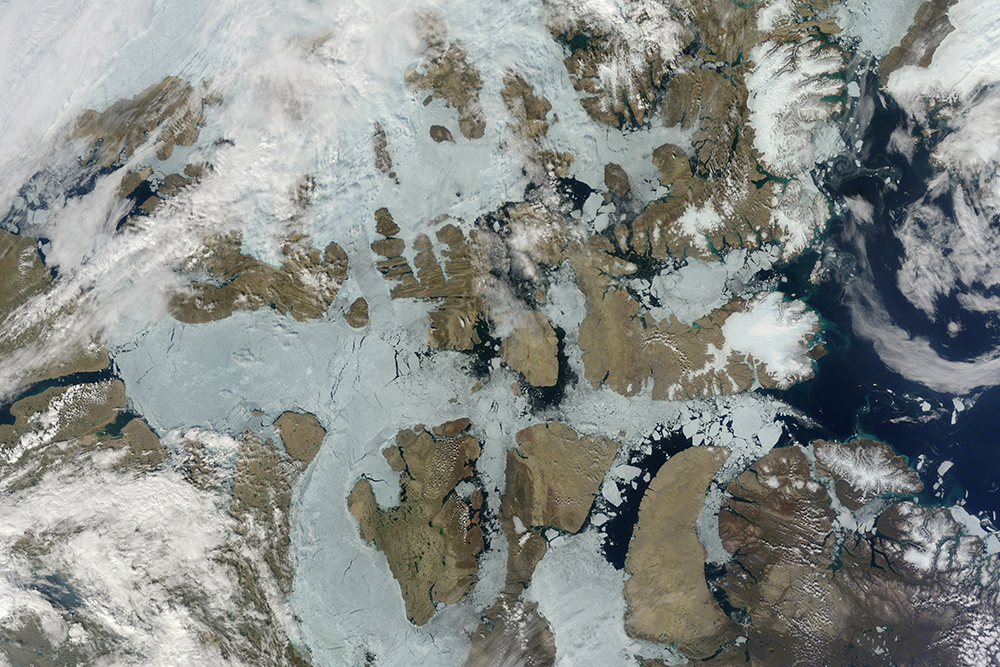
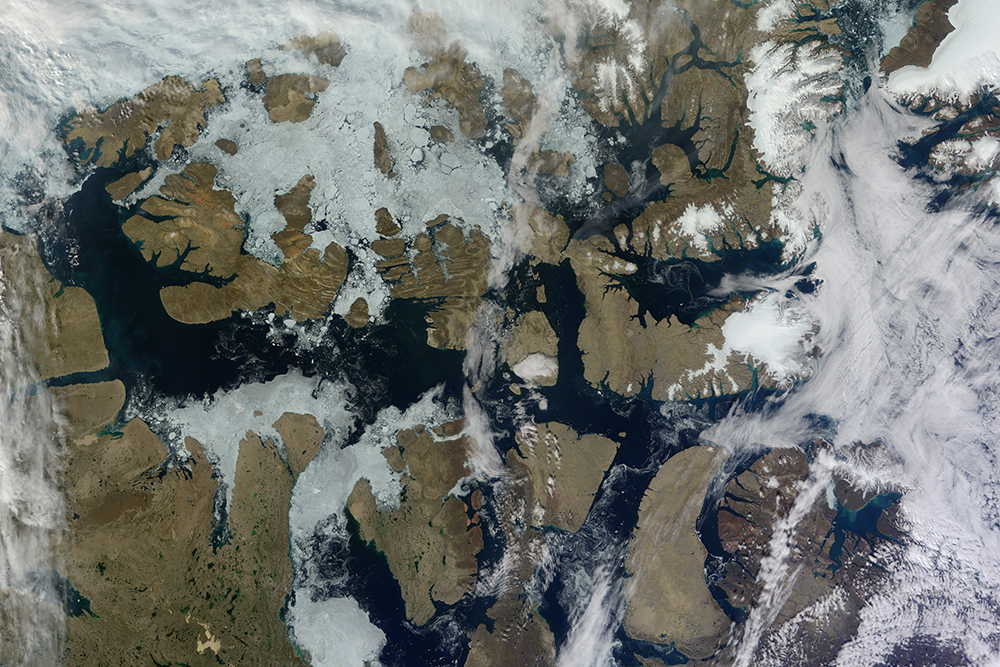
Despite their differences, both of these image types—the too close and the too distant—presuppose the possibility of documenting objective, single truths and, as such, I want to argue, they are too literal to contend with climate change. The figurative mode crumbles under its weight, fundamentally out of scale and character with the subject at hand. Moreover, both the on-the-ground, embedded view and the global view from afar tend to curtail political agency.16 While the former is typically deployed in activist struggles and therefore commonly associated with the political, unless it somehow opens onto wider contexts, such as the structural conditions leading to particular circumstances, it often remains too narrow in focus.17 Meanwhile, the satellite view subsumes particularities into totalities, in the process naturalizing, or depoliticizing, states of affair. In addition to masking its own operations, it fails to document, or even elides, the complex processes and relations through which climate change has come into being, including the socially uneven production and distribution of its many effects. In short, both of these widespread visual tropes blur or conceal crucial contexts, conflicts, and contingencies.
Indeed, one of the key representational challenges that climate change poses is how to maintain a degree of resolution fine enough to capture interrelations that are dispersed across time and space, and are often radically asymmetrical in nature. In his influential book on environmental “slow violence,” the postcolonial theorist Rob Nixon addresses climate change’s “unevenly universal” burden, as well as the misalignment between “calamities that patiently dispense their devastation” and are “marked above all by displacements—temporal, geographical, rhetorical, and technological,” and our spectacle-hungry, “flickering attention spans.”18 In a similar vein, Adrian Lahoud, within the context of his work on climate “forensics,” draws attention to the ways that broad planetary scales veil glaring inequities. In particular, he takes on the 2-degrees-Celsius warming limit that has become a de facto target for international climate policy. He explains, “The violent abstraction of a global average negates the uneven scale of climate impact and erases the specificity of people from its calculation. A two-degree average increase globally would allow for a catastrophic 3.5-degrees” in many places.19 This is, in fact, something that leaders from places like the Maldives, a low-lying island nation at acute risk from rising sea levels, have long argued, as captured in a brilliantly staged protest in the form of an underwater cabinet meeting from which President Mohamed Nasheed and his cabinet ministers sent an “SOS” message to the UN climate change summit in Copenhagen in 2009. In line with climate justice activists, especially those from the Global South, Lahoud calls for “a different scale of calculus,” one that would possess “just enough resolution to catch the uneven effects of temperature increase.”20
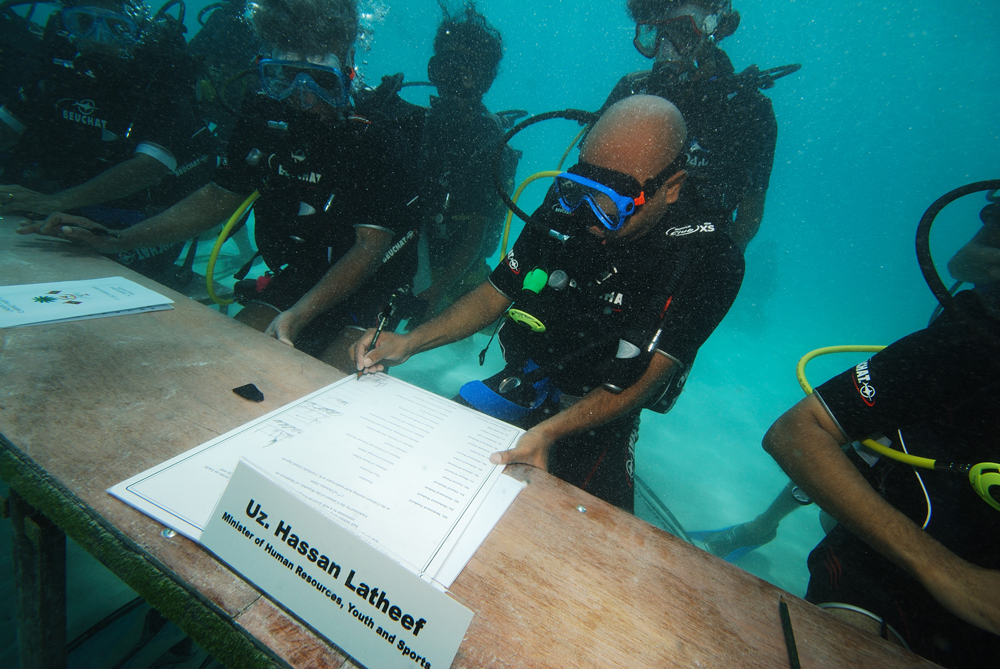
In light of these concerns and to reiterate my original question—from what position might we build and mobilize more adequate representations of climate change? In her 2004 book, Friction: An Ethnography of Global Connection, the anthropologist Anna Tsing proposes that it is “necessary to begin, again and again, in the middle of things.”21 For, where, exactly, does something like the global—or climate change, I would add—reside? Is it ever isolatable to one scene? Global connections, Tsing puts forth, “can only be charged and enacted in the sticky materiality of practical encounters.”22 So it is to friction, “the awkward, unequal, unstable, and creative qualities of interconnection across difference,” that our attentions must turn.23 Extending from this, I, like others, want to advocate for perspectives that are highly situated yet move across registers and scales—both spatial (e.g., the so-called local and global) and temporal (e.g., historical time, evolutionary time, and media time). Distinct from an ocular-oriented zooming in and out, such as that enacted in Charles and Ray Eames’s well-known 1977 film, Powers of Ten, it is representations that engage multiple, ultimately incommensurable scales and registers (e.g., the molecular, bacterial, geopolitical, geological, and architectural, visible, invisible, material, speculative, and so on) that best suit our present moment.
A People’s Archive of Sinking and Melting, initiated in 2011 by the California-based artist Amy Balkin, is, as she describes it, “a collection of materials contributed by people living in places that may disappear because of the combined physical, political, and economic impacts of climate change … Together … they form an archive of what will have been.”24 The artifacts thus amassed—of modest scale and carrying oblique reference to both their sites and acts of collection (the artist is clear that anything that “happens to be there” is welcome)—include a desiccated mango pit gathered along the shoreline of a small fishing village in Senegal, a pebble from the Ninth Ward of New Orleans, and a rusted nautical hook from Palmer Station on Anvers Island in Antarctica. This participatory archive is rooted in mundane objects that together bear situated, poly-vocal witness to real and projected events. While reminiscent of an eighteenth-century Wunderkammer in terms of its eclecticism, this bevy of curiosities is not meant to consolidate one vision or experience of the world, but, on the contrary, to serve as “community-gathered evidence” or “a public record,” in the artist’s words.25 It is counter-official documentation that she and the archive’s donors are building, both political and elegiac in its tone.
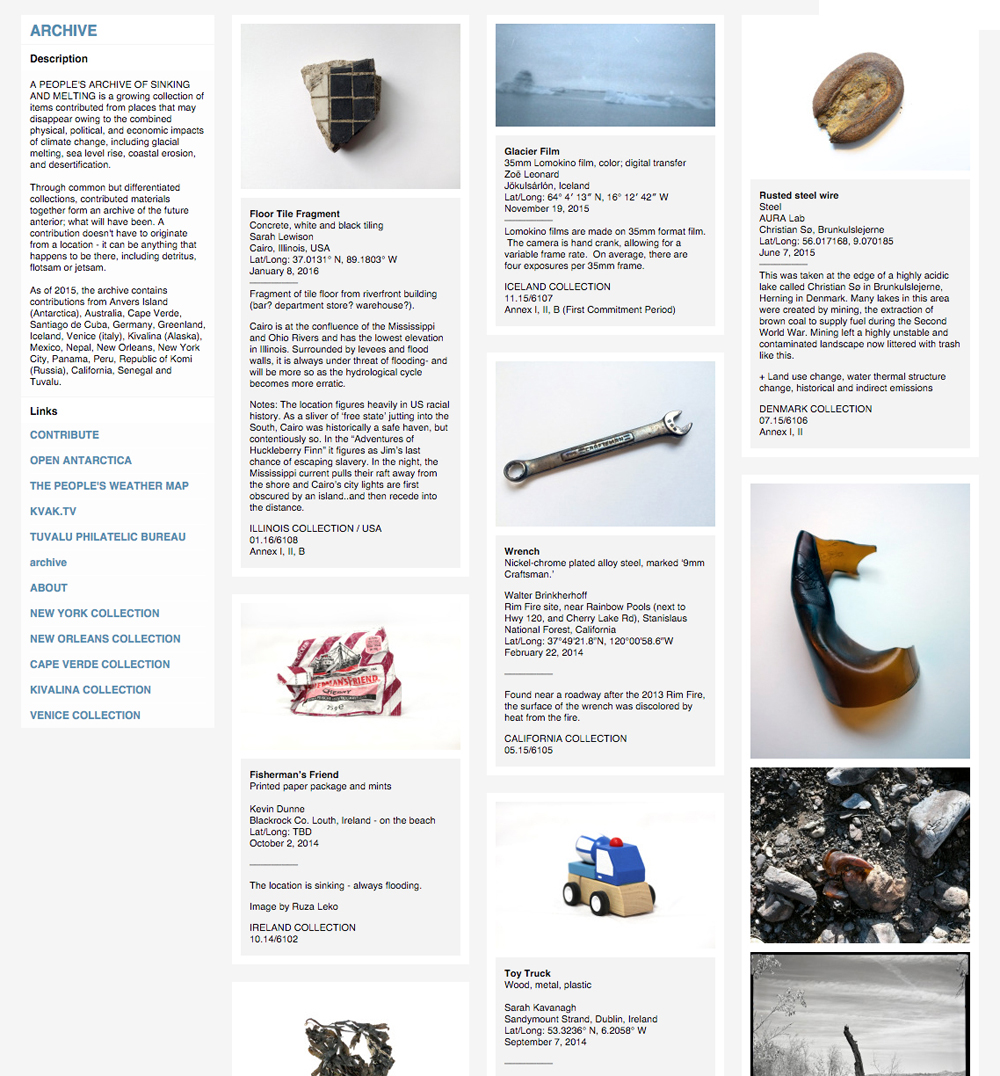
The mostly everyday ephemera comprising the collection have already been cast off as debris—flotsam and jetsam of the contemporary and recent past deemed too insignificant for remembrance, preservation, or even proper disposal, in many cases. Yet, here, within the context of the archive, they are converted into touchstones. Touchstones that are, significantly, things we might theoretically hold in our hands, turn over, inspect closely. Lesser in size and potential nostalgic value than ruins, they serve as intimate, material markers of another person’s point of contact. As such, they represent a fundamentally different type of index than a photograph or forensic shred, conveying a more multiple and indirect relation between event and trace, emission and reception.
Under the stewardship of Balkin, these archival objects are not abstracted or calibrated in order to become part of a cohesive sum. Instead they maintain their peculiarity—each tied to a story that we might begin to imagine from the basic details sketched by its collector(s). No single artifact stands in place of all others (as with the symbolic lone polar bear), nor does any attempt to capture a comprehensive view. Rather, like the human subjects who have ushered them into this unlikely fold, each stands as a fragment within a larger, not at all smooth context. Balkin refers to them as “common but differentiated,” appropriating language from the Kyoto Protocol of 1997 to acknowledge the “common but differentiated responsibilities” of those developed, industrialized nations that are largely responsible for creating climate change versus those that have contributed almost nothing to the problem yet bear its brunt.26 In so doing, she steers her gesture into the sphere of international environmental law and, more specifically, environmental justice. Elsewhere, she has characterized the archive’s various specimens as “political proxies” for their respective contributors.27 The archive is not political in straightforward or instrumental fashion, however. Instead, Balkin is curious, as she has been in previous projects, about “what the shape of political resistance in the difficult-to-inhabit space of the atmosphere might look like.”28

In a permanent state of unfinished-ness, A People’s Archive of Sinking and Melting is oriented toward an already unfolding future yet is situated firmly in the present. As such, it differs sharply from works of contemporary art and design that invoke “alternative futures,” often with a strikingly utopian overtones. It occupies an odd and overlapping temporality, what Balkin calls the “future anterior,” asking us “to think forward in time to look back.”29 In a recent interview with the art historian T. J. Demos, she addressed this “doubling of temporal perspectives,” saying that the archive simultaneously serves as “a ‘time capsule’ for a near future when hundreds of millions of people are likely to be displaced” and “a ‘public display of evidence’ for a present when grave mistakes are being made.”30 The project’s aim to construct a forum for collectively articulated testimony and long-term memory is particularly poignant in the midst of our accelerated age of quick-fire obsolescence. Indeed, Balkin’s choice to use the medium of the archive—which like the museum, library, and other cultural institutions is aimed at holding the present in perpetuity—raises all sorts of questions about futurity itself, including by? and for whom?

Balkin’s archive likewise relates to archives of a more scientific cast, including the emergency biological “banks” that have proliferated in the last several years in response to growing recognition of an abrupt and sweeping worldwide plummet in biodiversity, which many now consider to be the sixth mass extinction in Earth’s history.31 Take, for instance, the Svalbard Global Seed Vault (SGSV), situated halfway between mainland Norway and the North Pole on the icy island of Spitsbergen. The largest secure seed storage facility in the world, it was established to protect crop diversity as both plant varieties and arable land dwindle due to factors including urbanization, over-farming, pesticide use, and the genetic modification of seeds by corporate giants like Monsanto (one of SGSV’s main financiers). Nicknamed the “Doomsday seed bank,” it currently houses almost one million samples comprising thousands of seed species within the frigid recesses of an Arctic mountain.32 While intended to be tapped at an unknown future date only under dire circumstances, the first withdrawal of seeds was in fact authorized in 2015, upon a request by researchers in Aleppo, Syria, whose own facility was destroyed in the ongoing war there—a war spurred in part by a multiyear drought resulting from climate change.33

We might also consider the “living collections” of animal species at (or past) the brink of extinction that are maintained by biologists, such as the highly endangered tree snail populations preserved at the University of Hawaii. The environmental humanities scholar Thom van Dooren refers to this laboratoryas an “ark,” like Noah’s—“a place of last refuge” wherescientists tend to creatures with remarkable care, in spite of the devastating and unstoppable disappearance, in some cases, of entire species.34 Van Dooren’s interest lies in ways that projects like these, “engaged in practical and concrete acts of care,” help hold open the possibility for both hope about the future well-being of the world and a deepened sense of accountability.35 In the end, he calls for banking practices that—in addition to fulfilling their preservation missions—also “make visible all those things that they cannot quite hold on to and all those that they cannot hope to ever restore,” so as “to cultivate some semblance of responsibility for another, whose world we (collectively) have destroyed.”36
A People’s Archive of Sinking and Melting is a representation—if we want to even call it that—which likewise addresses the world as it is breaking through a series of acts that are at once mournful and lively, idiosyncratic yet related. In contrast to a techno-scientific view from above, its objects-acts reflect positions on the ground. Any fantasy of discrete sites and events, however, is replaced by a loose set of alliances drawn between people in places that are undergoing related processes of environmental destruction.
It is strangely fitting that climate change—this biggest of imaginable phenomena, this “thing” which is everything—assumes the form of a motley assembly.37 An assembly that does not depict or explain. That does not coalesce into a single picture. That sits between an unfolding present and imminent and/or imagined futures. That entails a series of non-monumental acts, each performed with great care, from the plucking of artifacts at their found contexts, to the collectors’ recordings of such details, to the methodical maintenance of the archive by the artist. And finally—an assembly that poses a humble yet expansive invitation for us to begin cobbling our various (inevitably partial and imperfect) views of the world, refracted perhaps through a mud-soaked slipper, abandoned seashell, crumpled wrapper, or some such.
-
Rebecca Solnit, “Are We Missing the Big Picture on Climate Change?” New York Times Magazine, December 2, 2014, link. ↩
-
Jodi Dean, “The Anamorphic Politics of Climate Change,” e-flux journal 69 (January 2016), link. ↩
-
The philosopher Timothy Morton has famously applied the term “hyperobject” to those contemporary more-than-things, like atomic radiation and global warming, that are, as he characterizes them, “massively distributed in time and space” (1), that we “can’t directly see or touch” (12), that have “no center and … no edge” (17), in which “gigantic scales are involved—or rather such knotty relationships between gigantic and intimate scales” that “the social and psychic tools we use to measure them” are utterly confounded (47), and, ultimately, that are “directly responsible for … the end of the world” (2). Timothy Morton, Hyperobjects: Philosophy and Ecology after the End of the World (Minneapolis: University of Minnesota Press, 2013). ↩
-
Rachel Louise Carson, Silent Spring (1962; repr. Boston: Houghton Mifflin, 1992), 238. ↩
-
Emily Apter, “Planetary Dysphoria,” Third Text 27 (January 2013): 140. ↩
-
See, in particular: John H. Richardson, “When the End of Civilization Is Your Day Job,” Esquire, July 7, 2015, link, and Meghan Walsh, “It’s the End of the World—How Do You Feel?” OZY, October 26, 2015, link. ↩
-
Anna Lowenhaupt Tsing, Friction: An Ethnography of Global Connection (Princeton, NJ: Princeton University Press, 2004), 1. ↩
-
By “newly complex entanglements between the human and nonhuman” I mean the thoroughly hybridized state of the world, in which any notion of a clear distinction between “nature” and “culture” has become untenable, and that is underscored by everything from the existence of “plastiglomerates,” a recently discovered geological specimen made of melted plastic fused with rock, to various biotechnological developments, to the presence of synthetic contaminants in even the remotest of locations. A handful of forward-thinking ecologists has adopted the term “ecological novelty” to capture this condition, while “emergent ecologies,” “post-nature,” and indeed “the Anthropocene” also speak to this reality. ↩
-
Susan Sontag, “The Imagination of Disaster,” reprinted in Against Interpretation and Other Essays (New York: Dell Publishing Co., 1966), 216. ↩
-
The Collapse of Western Civilization: A View from the Future (New York: Columbia University Press, 2014), by the historians Naomi Oreskes and Erik M. Conway, is one example of a work by scholars that engages the genre of science fiction in order to work through the present. The recent writings and performance–lectures of the sociologist Bronislaw Szerszynski, which invoke extraterrestrial, futuristic, and ghostly personae, are another noteworthy instance. ↩
-
Dean, “The Anamorphic Politics of Climate Change.” ↩
-
Solnit, “Are We Missing the Big Picture on Climate Change?” ↩
-
Michael Benson, “Gorgeous Glimpses of Calamity,” New York Times, August 13, 2013, link. ↩
-
For detailed discussions of the photographs originating from NASA’s Apollo space mission (1963–72) as well as how they have been culturally absorbed and put to work, see: Denis E. Cosgrove, Apollo’s Eye: A Cartographic Genealogy of the Earth in the Western Imagination (Baltimore: Johns Hopkins University Press, 2001), and Laura Kurgan, Close-Up at a Distance: Mapping, Technology, Politics (New York: Zone Books, 2013). ↩
-
The global and planetary arguably carry different connotations with regard to their respective positioning of the human. The global scale/perspective is closely tied to understandings of globalization, especially in the mid-twentieth century forward via the emergence of telecommunication networks, intensified international trade, multinational corporations, uneven geographical development, the aforementioned images of the Earth from outer space, and so forth—all linked directly to human life. See Paul Edwards’s ambitious book on global thinking relative to climate change: A Vast Machine: Computer Models, Climate Data, and the Politics of Global Warming (Cambridge, MA: MIT Press, 2010). The planetary, meanwhile, brings the physical and natural world, Earth systems, etc.—the nonhuman, so to speak—into its purview, as well as a broader extraterrestrial context. In spatial terms, we might link the former, in its address of tightly interconnected networks across a surface, to horizontality, and the latter to a more vertical orientation. The scholar Jennifer Wenzel offers a highly useful discussion of the two in relation to each other, including a survey of key thinkers on the matter, from anthropologist Tim Ingold to postcolonial theorist Gayatri Spivak in her essay “Planet vs. Globe,” English Language Notes, vol. 52, no. 1 (October 2014): 1–30. ↩
-
In their brief examination of the imagery invoked during the 2010 BP oil spill in the Gulf of Mexico, the historian of science Peter Galison and art historian Caroline Jones address three tropes, all of which they deem politically disabling: pictures of oil-soaked animals tended to by emergency workers (suggesting to viewers that the front line is being well cared for by others); satellite and other techno-scientific representations, which they associate with the sublime and aesthetic remove; and the “spill-cam” footage of that which we could see in grainy, seemingly close-up, real-time detail, deep down on the sea floor, but had no power to stop—an experience they liken to “environmental torture.” Their own analysis has been formative to my own thinking. Peter Galison and Caroline Jones, “Unknown Quantities,” Artforum, vol. 49, no. 3 (November 2010): 49–51. ↩
-
I realize that I’m painting a very broad picture here, and, in particular, that there is a wide gap (or even diametric opposition) between the kind of foreground-oriented, close-up images of tragic wildlife in mainstream environmentalist nature photography and those that document or otherwise emerge from social and environmental justice activism. The art historian T. J. Demos makes a strong case that it is precisely documentation of resistance on the ground, using the medium of photography, that has the most potential to counter the far too often apolitical nature of Anthropocene- and climate-change-related visual culture. T. J. Demos, Fotomuseum Winterthur blog (May–June 2015), link. ↩
-
Rob Nixon, Slow Violence and the Environmentalism of the Poor (Cambridge, MA: Harvard University Press, 2011), 6. ↩
-
Adrian Lahoud, “Nomos and Cosmos,” e-flux journal 65: SUPERCOMMUNITY (May 2015), link. ↩
-
Lahoud, “Nomos and Cosmos.” ↩
-
Tsing, Friction, 2. ↩
-
Tsing, Friction, 1. ↩
-
Tsing, Friction, 4. ↩
-
T. J. Demos, “The Law of the Land: An Interview with Amy Balkin,” in Amy Balkin: (IN)VISIBLE MATTER, ed. Edwin Coomasaru and Tom Snow (International New Media Gallery, 2013), link. ↩
-
For further information on the Kyoto Protocol, see the United Nations Framework Convention on Climate Change (UNFCCC) webpage that includes its full text, in multiple languages, link. ↩
-
Dana Kopel, “What Will Have Been: Interviews on A People’s Archive of Sinking and Melting,” the Brooklyn Rail, June 5, 2014, link. ↩
-
Demos, “The Law of the Land.” For a discussion of additional projects by Balkin that engage atmospheric politics, see also Theresa Deichert, “Amy Balkin and ‘Art Activism’: A New Approach to Environmental Activism,” in Amy Balkin: (IN)VISIBLE MATTER, link. My own essay, “Field Effects: Invisible-5’s Illumination of Peripheral Geographies,” Art Journal (Winter 2010): 38–47, examines a 2006 critical audio tour about environmental injustice and resistance along the Interstate 5 corridor in California developed by Balkin and collaborator Kim Stringfellow. ↩
-
Demos, “The Law of the Land.” ↩
-
Demos, “The Law of the Land.” ↩
-
For a lucid and expansive account of the catastrophic extinction event through which we are living, and that is of our own making, see Elizabeth Kolbert, The Sixth Extinction: An Unnatural History (New York: Picador, 2015). Numerous articles have been published in the last several years—too many to count and with new ones appearing almost daily—about the extreme rate of species extinctions currently under way. Some claim that we are on the “brink” of a mass extinction event; others, that we are already in its midst. While there is not an agreed upon start date for this trend, from what I understand, it maps loosely onto the so-called Anthropocene, and more specifically, “The Great Acceleration,” which began in the mid-twentieth century. ↩
-
Among many other sources on the Svalbard Global Seed Vault, see the art-research project by Annesofie Norn, Signe Lidén, and Steve Rowell, The Cold Coast Archive (2012–ongoing), link. ↩
-
On the release of seeds from the vault to Syria, within the context of a larger effort to protect seed diversity in the face of war, see Robin Schulman, “Sowing the Seeds of Syria: Farming Group Rescues Plant Species Threatened by War,” the Guardian, November 4, 2015, link. On climate-change-induced drought as a key trigger for the ongoing war in Syria, see, among other sources: Audrey Quinn and illustrator Jackie Roche, “Syria’s Climate Conflict,” September 4, 2015, link. ↩
-
Thom van Dooren, “The Last Snail: Loss, Hope, and Care for the Future,” in Land & Animal & Nonanimal, ed. Anna-Sophie Springer and Étienne Turpin (Berlin: K. Verlag and the Haus der Kulturen der Welt, 2015), 1. ↩
-
Van Dooren, “The Last Snail,” 6. ↩
-
Van Dooren, “The Last Snail,” 13. ↩
-
I arrive at the term “assembly” because of its simultaneous evocations of: a place or event where people gather, often toward a common purpose, to air their various perspectives; of a thing made of multiple components fitted together; and lastly, although somewhat less proximate to my concerns, of assemblage— the art form of three-dimensional, or sculptural, collage, which has historically involved the collection and fusing of junk and other found materials, especially by artists in the mid-twentieth century (e.g., Louise Nevelson, Joseph Cornell, and Robert Rauschenberg). ↩
Emily Eliza Scott, currently a postdoc in the architecture department at the Swiss Federal Institute of Technology (ETH Zürich), is an interdisciplinary scholar, former park ranger, and founding member of two long-term, collaborative, art-research projects: World of Matter (2011–ongoing) and the Los Angeles Urban Rangers (2004–ongoing). Her writings have appeared in Art Journal, American Art, Third Text, and Cultural Geographies as well as multiple edited volumes and online journals; she is also co-editor, with Kirsten Swenson, of Critical Landscapes: Art, Space, Politics (University of California Press, 2015).

